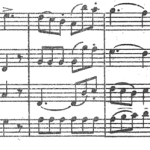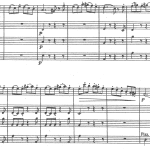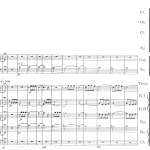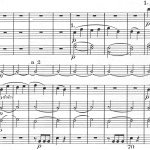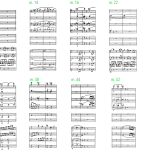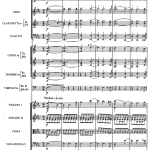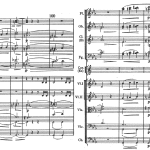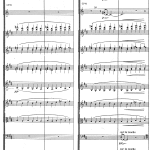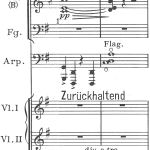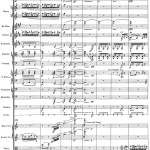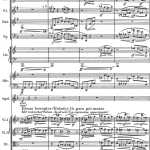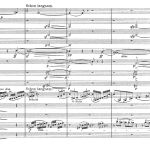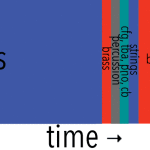Utilizing the orchestra, whatever the forces employed, is very much about designing longer time spans – at times entire movements or even a sequence of movements – with regard to sound characteristics, sonority and timbre. This subject, extensive but not directly related to idiomatic orchestral practice, will here be addressed primarily as a series of observations.
The symphony orchestra of the 1700s was dominated by the strings – a homogeneous group of instruments with access to all keys in all registers. The narrower ranges of the woodwinds and their technical correlation with the overtone series naturally limited their use, but apart from doubling and coloring the strings, they frequently appeared as soloists. Instruments such as natural trumpets and to some extent also natural horns were – apart from their very high register with closely spaced overtones – basically limited to highlighting dynamic climaxes. But even the First Viennese School exploited instrumental disposition and tone color in order to achieve distinct structural identity and contrast in the organization of form.
The development of sonata form eventually brought about a clear dualism between the first and the second subject, a difference still characterized by some as “male” versus “female.” This led to consequences for the symphonic sonata form, since the orchestra offered refined opportunities to clarify and highlight this difference. In the music of Haydn, the evolution of thematic dualism appears only hesitantly in some of his late symphonies, at times emphasized by the contrast between strings and winds or between solo and tutti. The difference between the two themes may also be underlined by using different types of accompaniment. But as late as Symphony No. 101 (“The Clock”), the main subjects still seem like two sides of the same coin with regard to both character and instrumentation.
Figure 163 · Haydn, Symphony No. 101, 1st movement, m. 24, first subject
Figure 164 · Haydn, Symphony No. 101, 1st movement, m. 80, second subject
In Mozart, certainly in his mature symphonies, this dualism is always clearly emphasized (cf. figure 30 and figure 34). And in the music of Beethoven, dramatic contrasts become the norm.
Figure 165 · Beethoven, Symphony No. 5, 1st movement, m. 1, first subject
Figure 166 · Beethoven, Symphony No. 5, 1st movement, m. 59, second subject
The great vitality of the sonata form through more than a century was due not least to the fact that it generated both kinetic energy and unity by means of tonality. It created an experience of “at home – away – back home” through the harmonic progression from tonic via dominant to more distant keys in the so-called development section and back to the tonic again. In traditional sonata form, the second subject appears in the dominant key in the exposition (or in the parallel key if the main key is minor), while tonal completion and resolution require both themes to appear in the main key in the recapitulation. In symphonic sonata form, the necessary transposition involved frequently has implications for the instrumentation. Moving a melody or an accompaniment up or down from the dominant or parallel key to the main key may demand instrumental changes due to sonority, register or technical issues. Yet this was hardly considered to be an inconvenience, but rather an opportunity for extended variation of tone color. The identity of a theme is connected to melody rather than timbre, register or volume, and continuous variation in these areas is an important part of symphonic dramaturgy. The topic is an intriguing object of study for anyone with an interest in instrumentation and the design of musical form.
Purely technical issues may necessitate changes. Just a single example from Beethoven’s 5th Symphony: in the exposition, the natural horns (tuned in Eb) herald the second subject with a powerful version of the main theme, but cannot repeat this in the recapitulation due to the limited number of available tones, as the theme now must appear in C major. Beethoven replaced the horns with bassoons, but the change undeniably weakens the dramatic effect. Today it seems both tempting and reasonable to let the modern valve horn take over the motive.[1]
“Harmonic tempo” is a term describing the pace at which harmony changes, frequently in reverse complementary relationship to the actual tempo of the music. The exposition of the first movement of Beethoven’s Piano Sonata in C major, No. 21 (“Waldstein”)is a model example. Here the fast, nervous eighth notes of the first subject progress at a steady harmonic pace, while the slow cantabile of the second subject has a much faster harmonic tempo.
In the area of instrumentation, a concept such as “tone color tempo” may be similarly useful, designating the pace at which instrumental tone colors change. If Mozart’s orchestration at times may seem more colorful than that of Haydn, the reason lies not in a more extensive use of woodwinds and brass, but the fact that the instrumental disposition changes more frequently and more noticeably than in Haydn’s music. The 100-bar exposition of Mozart’s Symphony No. 40 in G minor incorporates no less than 18 changes of tone color, i.e. an average of one change of color every six bars.
Below the first ten of these changes:
Figure 167 · Mozart, Symphony No. 40, 1st movement
The change of tone color and the pace at which it occurs is a matter of expression, of course, rather than idiomatic practice. In general terms, however, it would hardly be an overstatement to claim that a score maintaining the same sound disposition over multiple pages uses the orchestra less idiomatically than a score with more frequent changes of disposition. Conversely, a multitude of incessant tone color changes can produce a grey and lifeless texture, either because the tone colors lose their characteristics – e.g. because of continual changes across different instrument groups – or because tone colors can “fade” if they occur over and over again. If an instrument (or a group of instruments) is reintroduced after having been silent for some time, the timbre will have a “freshness” to it that at times can be more effective than many sophisticated sound mixtures. Variation and contrast can be achieved with simple means when the ear suddenly experiences a timbre with renewed sensitivity.
In some contemporary scores one may find that the majority of orchestral tone colors is literally used all the time. If this is the result of a conscious choice, it should go unchallenged, of course – freshness of sound is clearly not a central issue here. Something similar applies to the use of different registers. When the whole range of the orchestra is employed over long stretches of time, there is a risk of a certain bleak redundancy. Conversely, the extreme economy in the use of sonorities and registers typical of Stravinsky’s late works has produced a goldmine of passages that exhibit a freshness of sound. Naturally, these can only be studied and appreciated in full over longer stretches of time or in the work as a whole. The Requiem Canticles and the Variations for Orchestra provide outstanding examples.
Clearly, these matters do not primarily concern the technical side of orchestration, but depend greatly on aesthetic and artistic considerations. Robert Schumann’s instrumentation has frequently been criticized for excessive use of doublings, merged tone colors and problematic balance. But the myth about Schumann’s massive, clumsy instrumentation (repeated over and over again without supporting evidence, even in more recent historical presentations) completely ignores the particular sound of his orchestra. Schumann’s orchestra functions as a kind of organism, not a palette of countless individual colors. He increasingly preferred the full sound spectrum of the orchestra to constant shifts between colors, pursuing homogeneous orchestral textures and an original, mostly transparent flow of mixed sonorities.
Figure 168 · Schumann, Symphony No. 3, m. 1
Figure 169 · Schumann, Symphony No. 3, m. 95
In Schumann’s 3rd Symphony, the “Rhenish” – his last, since the 4th is actually a revision of an earlier symphony – the dualism between first and second subject is apparent, but both themes mix winds and strings without separating them into melodic and accompanying segments.
At the beginning of the 20th century, the differences between German (Wagner-influenced) and French orchestration became increasingly evident, the latter – as previously mentioned – with roots in both Berlioz and Rimsky-Korsakov. Debussy referred to Wagner’s use of the orchestra with admiration, but described Strauss’ orchestration as “an American cocktail with 18 ingredients.” A comparison between Strauss’ Ein Heldenleben and Debussy’s Nocturnes, both written in 1899, may illuminate these differences in more detail.
For Richard Strauss, orchestration revolved above all around perpetual variation. Exact repetitions are entirely absent, counterparts are added, registers change and instrumental groups alternate ceaselessly (cf. figure 86).
Debussy’s imagination and originality is naturally connected with his endeavor to constantly transform the substance of his music. He does not double lines just to obtain greater volume, but to create new tone colors and overtone spectra, and at the same time exploit specific tone colors as a structurally expressive device.
In Trois nocturnes,each movement has its own characteristics – the brass appears for the first time in the second movement, the choir not until the last movement. In the first movement, shaped in classical ABA-form and limited to woodwinds and strings, instruments are consistently linked to particular formal elements. The characteristic descending melody that dominates the A-section occurs nine times, each time played by the English horn and each time “answered” by the horn (at times supported by double bass).
Figure 170 · Debussy, Nocturnes, “Nuages,” number 2, m. 7
The English horn exclusively appears in this single thematic element. The B-section of the movement introduces a new melody, played three times by flute and harp, the only occurrence of these two instruments (apart from the flute taking part in a single chord in the movement’s opening). Solo strings are assigned a prominent role twice: a counter-melody for solo viola is added to the homophonic passage in the woodwinds just before the transition to the B-section, and the flute + harp melody of the B-section is answered by three soloists – violin, viola and cello.
Efficient planning and use of clearly delineated, easily identifiable tone colors to establish structural cohesion is typical of “French” orchestration, and has previously been pointed out in passages from Stravinsky’s Le sacre, figure 48, figure 49 and figure 50.
Gustav Mahler occupies a special position, as his innovations in several respects maintain an equal distance from Wagner/Strauss on the one hand, and Debussy on the other.
Figure 171 · Mahler, Symphony No. 4, 3rd movement, m. 55
Here Mahler anticipates the thinking behind Schoenberg’s “Farben” (cf. figure 97, Active Harmony) – almost imperceptibly, the sound of the woodwinds passes over to violas and harp.
Mahler’s use of dynamics as an integral part of tone color and texture is unique – the individual parts have a highly unusual level of independent, detailed, sometimes almost quirky dynamics. By isolating the sound level of separate groups of instruments and using different, at times conflicting dynamic markings in single instruments or groups, Mahler creates a highly original soundscape, although Berlioz was an early pioneer in this regard as well. If the use of four to five different but simultaneous dynamic markings may seem somewhat illusory, considering their irrefutable lack of precision, it should be remembered that Mahler, one of the most renowned and experienced conductors of his time, always conducted the first performance of his works himself.
Mahler presents his material in sharp, often pungent tone colors, frequently in the extreme registers of the instruments, entirely devoid of the playful ornamentation and humming secondary voices typical of Strauss. And while Strauss always bases his textures on a harmonic background, Mahler’s melodic lines often lack any chordal foundation. Individual dynamics and continually changing timbre and balance are ubiquitous in Mahler’s music. Furthermore, Mahler rarely makes use of the “orchestrated pedal” (cf. Reverberation Echo Resonance and Acoustic Reflection). His orchestral sound is dry, naked and economic, even when his orchestra is gigantic.
Figure 172 · Mahler, Symphony No. 6, 2nd movement, m. 29
By isolating the volume in separate groups, by staging light and shadow, foreground and background, close-up and depth like a set designer, Mahler achieves a unique sense of depth and perspective. The characteristic example below shows how individual dynamic fluctuations in single instruments continually transform the sound of musical phrases. A simple two-part counterpoint turns into full-bodied orchestral music despite the absence of a harmonic background.
Figure 173 · Mahler, Kindertotenlieder, “Nun will die Sonn’ so hell aufgeh’n,” number 8
Below a model case, a famous and striking passage in which two horns play diminuendo while two other horns play the same notes stopped with a crescendo (the player stops the bell with the left hand, resulting in a snarling, metallic sound). The sound of the horn, one of the most noble and mellow sounds of the orchestra, is gradually, imperceptibly transformed into one of the fiercest.
Figure 174 · Mahler, Symphony No. 9, 1st movement, number 12. m. 4
Carefully planned use of particular instrumental colors to delineate musical structure is a fascinating aspect of the historical development of the orchestra. The use of tone color to provide contrast was common already in the music of Bach, here usually in the form of “terraced dynamics” and shifts between a concertino group and ripieno (tutti) typically found in the concerto grosso. And Beethoven clearly used instrumental timbre to establish formal identity – in his 5th, 6th and 9th symphonies, for example, he limits the use of certain instruments to certain movements. In the 5th symphony, piccolo, double bassoon and three trombones take part only in the finale, where the increased sound power effectively marks the change from minor to major. Also the use of a “fresh” tone color as a means of defining particular formal sections is frequent in Beethoven: in the first movement of the 5th symphony, the solo oboe timbre is withheld until the surprising oboe cadence in connection with the return of the main theme of the recapitulation.
Berlioz similarly plans the independent identity of individual movements in his Symphonie fantastique. Three trombones, two tubas and percussion are used only in the final two movements, two harps are restricted to the second movement, an English horn to the third, and an Eb clarinet to the fifth.
A more recent example showing an extremely efficient and effective disposition of form by means of different instrumental groups is Lutoslawski’s Livre pour orchestre, Chapter 1.
Figure 175 · Lutoslawski, Livre pour orchestre (1968), Chapter 1
The illustration above is an approximate representation of the individual sound fields and their duration, showing that the different instrumental groups are not used at the same time. The instrumental disposition is very much a question of large-scale structural planning by means of tone color (apart from the double bassoon, the woodwinds, vibraphone, celesta and harp are withheld until the following movements).
As in many other areas of life, “neither too much nor too little” is a maxim that also applies to the use of individual musicians. In the preface to his republication of Berlioz’ textbook, Strauss declared his admiration for the care with which Wagner stimulated the “spiritual presence” of all participating musicians. Naturally, it is impossible to use all instruments in an orchestra to the same extent – some will by necessity have far more rests than others. But an experienced orchestrator makes sure that all musicians feel they are an important part of the whole, and that all are utilized to a reasonable extent. This may by achieved by using doublings or perhaps subordinate voices with the character of “pseudo-counterpoint” (cf. the previous examples from Strauss’ Ein Heldenleben, figure 86, figure 87 and figure 88, Foreground and Background – Melody and Accompaniment). Such discrete, inconspicuous individualizations of orchestral parts provide the musicians with more interesting material to play without significantly affecting the whole.
While string players – at least in principle – can play continuously without becoming overly fatigued, woodwinds and particularly brass players must have pauses to rest their embouchure (the lips and facial muscles). On the other hand, long rests and/or only few, short or insignificant things to play leave the instruments cold, weaken the musicians’ concentration and increase the risk of errors. In orchestral music written by experienced orchestra and – notably – opera composers (Richard Strauss is a prime example), the brass is often asked to play unobtrusive, discretely sustained notes. These are not primarily “binders” of sound, but serve to avoid that the instruments remain unused for longer time spans. Strauss further underlined that the single part must always appear coherent and meaningful in itself, as this enables the musicians to grasp their role as part of the whole far more easily and efficiently. Therefore, any orchestrator should always carefully read through every single orchestral part.
· · ·
Next · Chapter 14. Orchestra Size and Setting
· · ·
[1] The first movement of Beethoven’s Piano Sonata op. 31, No. 2 (“Tempest”) is an explicit example of how Beethoven had to change the epilogue theme (m. 58ff) in the recapitulation (m. 188ff) due to the narrower range of his fortepiano. And in the Sonata op. 31, No. 3 in Eb major, an octave transposition necessitates a change that transforms a characteristic motive into trite figuration (second movement, m. 54) for the same reason. When pianists today slavishly follow an “Urtext,” although in fact performing on a modern grand, resigned laughter is likely to resound from Elysium.
